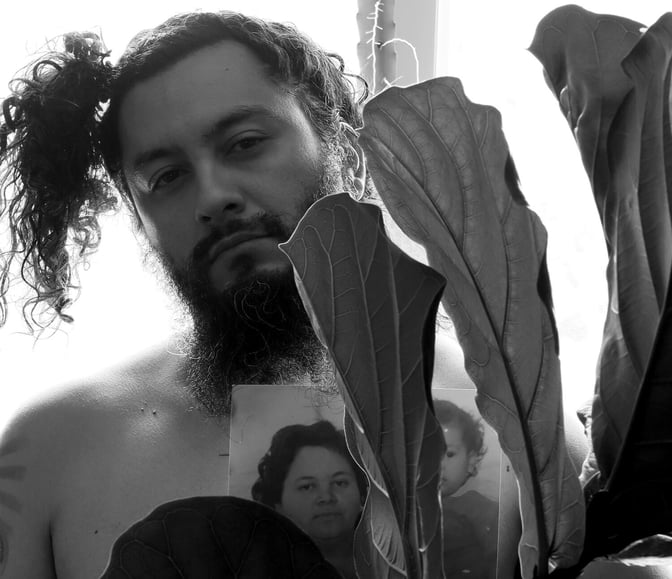Luis Sahagun on art as a representation of his identity
Bronwyn Hunter-Shortly on September 23, 2022
As we approach the launch of Peggy, we’re thrilled to give everyone a sneak peek into some of the Pegcasts that will be live on the app.
Bronwyn Hunter-Shortly, VP of Art at Peggy, chatted with Luis Sahagún about his journey in the art world, including how he first started creating art, and the role of community-based art in creating connections among different individuals.
We hope you enjoy the interview!
 Luis Sahagun. Credit: http://luissahagun.com.
Luis Sahagun. Credit: http://luissahagun.com.
Bronwyn Hunter-Shortly: Thanks for joining us. I'm excited to learn a little more about you, Luis. Your practice is community-based. Can you tell me a little bit more about that?
Luis Sahagun: All art, in a way, is public art. And if it's public art, then there's community engagement. I think for me to identify as a community based-artists means that perhaps I'm more intentional in my making when understanding that this object I'm about to create will spark some conversations. I want to be mindful. What type of conversations do I want to have with my communities and which communities live inside me that I want to connect with? Can I maybe feel a little disconnected and wanna use art as a way to come together a little bit more? So I think I identify as a community-based artist in that sense. I'm constantly thinking about how my art will function in a space, in a different environment, and with other people.
BHS: I love that point that you made that your art will connect different communities. And you're thinking about it in that way. So you wouldn't need the viewers to all come away with the same message. You're hoping they bring their own context and experience to the pieces.
LS: Absolutely. I think we all see the world very differently and very similarly. I think I like to point that out in my artwork. There will always be different interpretations of the artwork that is also exciting for me to hear and learn about when people see the work.
BHS: That's so interesting. I love learning about different people, contexts, and backgrounds. That really comes through art for me, mainly because if you are enjoying a piece and then you read or learn a little bit more about the context in which it was made, you get this extra layer and level of understanding, which I think is so magical.
LS: I think that's why I fell in love with art before I was an artist. I was a product designer, and I used to design furniture. One of my first experiences with art was when I was doing an internship at a not-for-profit in a local community, and I made a drawing on cardboard. It was one of the first drawings I've ever done that got exhibited in a gallery. I would go out into the street and collect huge pieces of cardboard, the size of a door or two doors, and I would draw on them. I drew an enormous bird once, so it's a little silly. I drew this without thinking much, just putting emotion into it, and then, at the exhibition, it was one of the first times I realized how powerful art could be. All of a sudden, it felt to me that people were interested in my artwork, and people were interested in what I had to say as a person.
For me, this is important, because I grew up undocumented. I was part of the south side, but also in the suburbs, where I felt disconnected, like a stranger in my own home. When I started to create, and I began to put these objects on a wall, people who looked different than me and normally wouldn't engage in a conversation just started talking to me. I felt the power of communicating, connection, and belonging in a community.
BHS: That's a beautiful journey. It's so interesting that you say people would interact with the work, and then you'd be able to talk to them, whereas you didn't have that point of communication before. Art brings different people together because they have common ground that they can discuss, feel, and relate to. Art has that unique, spontaneous effect. What drew you to found objects and in creating art on them? Was there something in particular?
LS: It was instinct for me. When I walked in my communities, I’d see cardboard all over the place. I started to empathize with the material. I couldn't help but sense that the material was a reflection of how I felt in society. The piece of cardboard was this piece that was in the street, thrown away, and discarded. It was used and stamped with an identity already.
The cardboard is a box. You use it for shipping; it's this rough material that you don't think twice about throwing away, but is essential in our lives. I started to see these parallels between what it meant for me to grow up brown in the United States, and how I felt society treated me. I started to pick up the pieces of cardboard and making drawings on them. The initial connection to picking up something discarded was because I felt I was being dumped by society. I was trying to make sense of that. It started my journey to reclaim my power and my position in society. People could look at the work and understand it and relate it to cardboard, but when you add that extra layer of context, it makes it even more powerful. It's very much like a self-portrait.
